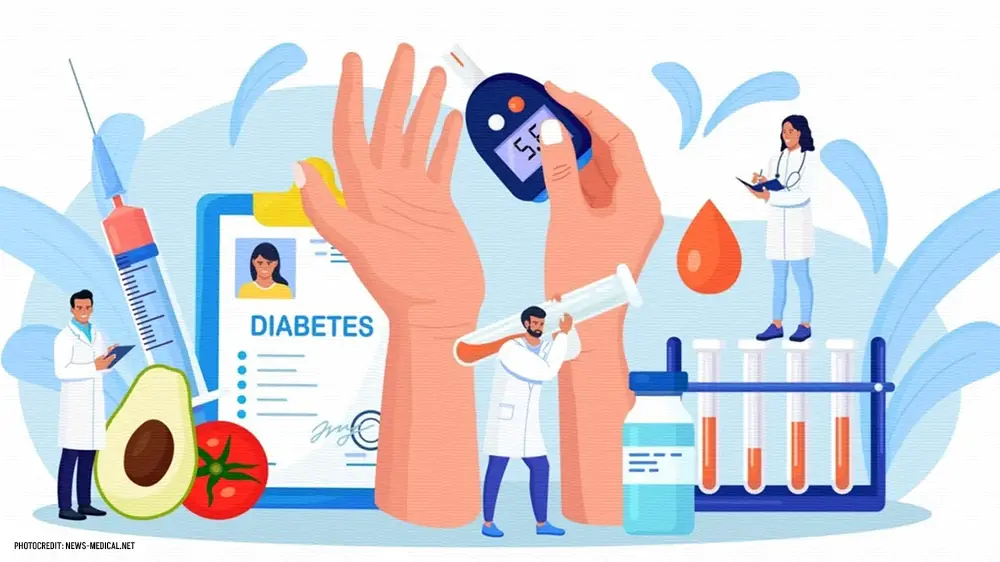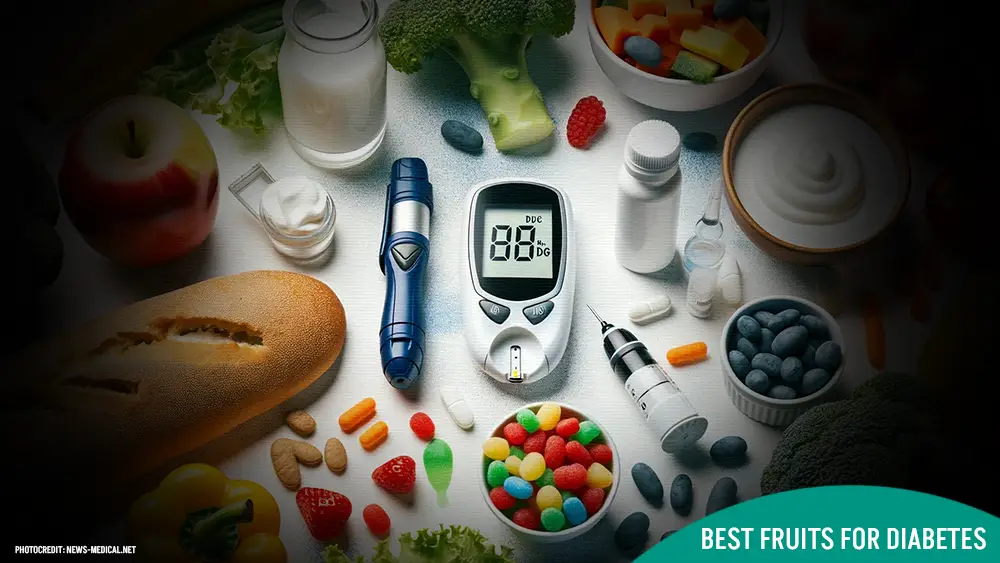
HEALTH BLOG
10 Best Healthy Fruits List for Diabetes Control and Their Importance
-
 Rahul Priydarss
Rahul Priydarss - March 10, 2024
Discover the top 10 healthy fruits for effective diabetes control and learn about their importance in managing blood sugar levels. Explore the benefits of incorporating nutrient-rich fruits into your diet, along with practical tips for diabetes-friendly meal planning. Consult with healthcare professionals for personalized dietary guidance tailored to your individual health needs and goals.
Introduction to Diabetes and The Importance of Diet:
Diabetes is a chronic medical condition characterized by high blood sugar levels (glucose). It occurs either when the body doesn’t produce enough insulin or when the cells don’t respond effectively to the insulin produced. Insulin is a hormone produced by the pancreas that helps regulate blood sugar levels and allows glucose to enter the cells to be used for energy.

Table of Contents
Types of Diabetes:
There are primarily three types of diabetes.
1- Type 1 Diabetes: In this type, the immune system attacks and destroys the insulin-producing beta cells in the pancreas. Consequently, the body produces little to no insulin. Type 1 diabetes typically develops during childhood or adolescence and requires lifelong insulin therapy for management.
2- Type 2 Diabetes: This is the most common form of diabetes, accounting for the majority of cases. In type 2 diabetes, the body either becomes resistant to the effects of insulin or doesn’t produce enough insulin to maintain normal blood sugar levels. It is often linked to lifestyle factors such as poor diet, lack of physical activity, and obesity. Type 2 diabetes can often be managed with lifestyle changes, including diet and exercise, although medication or insulin therapy may also be necessary.
3- Gestational Diabetes: Gestational diabetes develops during pregnancy and is characterized by elevated blood sugar levels that occur for the first time during pregnancy. It usually resolves after childbirth, but women who have had gestational diabetes are at higher risk of developing type 2 diabetes later in life. Gestational diabetes can increase the risk of complications during pregnancy and delivery if not properly managed through diet, exercise, and sometimes medication.
Other less Common Types of Diabetes Include:
Monogenic Diabetes: This type of diabetes is caused by mutations or changes in a single gene and is often diagnosed in infancy or early adulthood. It includes forms such as maturity-onset diabetes of the young (MODY) and neonatal diabetes.
Secondary Diabetes: Secondary diabetes occurs as a result of another medical condition or as a side effect of certain medications or treatments. Conditions such as pancreatitis, cystic fibrosis, and hormonal disorders can lead to secondary diabetes.
Importance of Diet Management for Diabetes:
The importance of diet in managing diabetes cannot be overstated. What people eat directly affects their blood sugar levels, and making healthy dietary choices is crucial for controlling diabetes and preventing complications. Here are some key principles of a diabetes-friendly diet.
Carbohydrate Management: Carbohydrates have the most significant impact on blood sugar levels. Individuals with diabetes need to monitor their carbohydrate intake and choose complex carbohydrates with a low glycemic index (GI) that are digested more slowly, leading to more stable blood sugar levels.
Portion Control: Controlling portion sizes helps manage calorie intake and prevents spikes in blood sugar levels. It’s crucial to be mindful of portion sizes, especially when consuming foods high in carbohydrates.
Balanced Meals: Meals should be balanced and include a combination of carbohydrates, protein, and healthy fats to help stabilize blood sugar levels and provide sustained energy throughout the day.
Fiber-Rich Foods: Fiber slows down the digestion and absorption of carbohydrates, which can help prevent spikes in blood sugar levels. Including plenty of fiber-rich foods such as fruits, vegetables, whole grains, and legumes in the diet is beneficial for diabetes management.
Limiting Sugary Foods and Beverages: Foods and beverages high in added sugars can cause rapid spikes in blood sugar levels and should be consumed sparingly or avoided altogether.
Healthy Fats: Incorporating healthy fats such as those found in avocados, nuts, seeds, and olive oil can help improve insulin sensitivity and reduce the risk of heart disease, which is often higher in individuals with diabetes.
Regular Monitoring: Regular monitoring of blood sugar levels and working closely with healthcare providers or dietitians can help individuals with diabetes make informed dietary choices and adjust their meal plans as needed.
Understanding Glycemic Index and Its Significance:
The Glycemic Index (GI) is a numerical scale used to measure how quickly and how much a particular food raises blood sugar levels after consumption compared to a standard reference food (usually pure glucose or white bread). Foods with a high GI are rapidly digested and absorbed, causing a rapid increase in blood sugar levels, while foods with a low GI are digested and absorbed more slowly, resulting in a gradual rise in blood sugar levels.
The significance of the Glycemic Index lies in its ability to help individuals, especially those with diabetes, make informed dietary choices to manage blood sugar levels effectively. Here are some key points to understand about the Glycemic Index and its significance.
Impact on Blood Sugar Levels: Foods with a high GI can cause rapid spikes in blood sugar levels, which may be undesirable, especially for individuals with diabetes. These spikes can strain the body’s ability to produce insulin or reduce insulin sensitivity over time. On the other hand, foods with a low GI result in slower, more gradual increases in blood sugar levels, promoting better blood sugar control and overall health.
Classification of Foods: Foods are typically classified into three categories based on their Glycemic Index.
Low GI (55 or less): Examples include most fruits and vegetables, legumes, whole grains, and non-starchy vegetables.
Medium GI (56-69): Examples include some fruits, whole wheat products, and some types of rice.
High GI (70 or higher): Examples include sugary foods, refined grains, white bread, white rice, and many processed snacks and desserts.
Role in Diabetes Management: Understanding the Glycemic Index aids in planning meals to minimize blood sugar spikes and maintain stable levels throughout the day. Choosing lower GI foods can help manage blood sugar, reduce reliance on insulin or medication, and lower the risk of diabetes-related complications such as heart disease and nerve damage.
Considerations for Meal Planning: Incorporating a variety of low to medium GI foods promotes better blood sugar control and overall health. Combining carbohydrates with protein, healthy fats, and fiber slows digestion, reducing the glycemic response of meals.
Individual Variability: Personal factors like metabolism and insulin sensitivity affect how foods impact blood sugar levels. While the Glycemic Index offers guidance, other factors like portion sizes and meal composition are also crucial considerations for managing diabetes effectively.

Benefits of Fruits in Diabetes Management:
Fruits offer numerous benefits for diabetes management.
Nutrient-Rich: Fruits are packed with essential vitamins, minerals, and antioxidants that support overall health and well-being, crucial for individuals with diabetes to maintain optimal nutrition.
Fiber Content: Most fruits are high in dietary fiber, which aids in slowing down the digestion and absorption of carbohydrates, leading to more stable blood sugar levels after meals.
Low Glycemic Index (GI): Many fruits have a low to moderate GI, meaning they cause gradual increases in blood sugar levels, reducing the risk of spikes that can be detrimental for those with diabetes.
Hydration: Fruits with high water content, such as watermelon, strawberries, and oranges, can help individuals stay hydrated, which is essential for overall health and can aid in blood sugar management.
Weight Management: Incorporating fruits into the diet can promote satiety due to their fiber and water content, potentially aiding in weight management, which is crucial for diabetes management and the prevention of complications.
Heart Health: Certain fruits, like berries and citrus fruits, are rich in antioxidants and nutrients that support heart health, reducing the risk of cardiovascular complications, which are common in individuals with diabetes.
Versatility: Fruits offer a wide variety of flavors and textures, making them versatile ingredients in meals and snacks, allowing individuals with diabetes to enjoy a varied and satisfying diet while managing their condition.
Natural Sweetness: Fruits can satisfy sweet cravings in a healthier way compared to processed sugars, helping individuals with diabetes manage their blood sugar levels while still enjoying a sweet treat.
Gut Health: The fiber found in fruits promotes a healthy gut microbiome, which is increasingly recognized as important for overall health and may play a role in managing diabetes and related complications.
Disease Prevention: Consuming a diet rich in fruits has been associated with a reduced risk of developing type 2 diabetes and other chronic diseases, emphasizing the importance of including fruits in the diet for both prevention and management of diabetes.
Top 10 Healthy Fruits for Diabetes Control:
Managing diabetes involves making smart dietary choices, and including fruits in the diet can be both delicious and beneficial. Here’s a detailed look at the top 10 fruits that are particularly advantageous for diabetes control.
Berries: Antioxidant Powerhouses: Berries such as strawberries, blueberries, and raspberries are packed with antioxidants, vitamins, and fiber. Their low glycemic index (GI) makes them ideal for regulating blood sugar levels, while their high fiber content aids in digestion and helps control appetite.
Apples: The Quintessential Fruit for Diabetes Control: Apples are rich in soluble fiber, which slows down the digestion and absorption of glucose, preventing spikes in blood sugar levels. They also contain antioxidants that help reduce inflammation and improve overall health.
Citrus Fruits: Refreshing and Beneficial: Citrus fruits like oranges, grapefruits, and lemons are not only refreshing but also beneficial for diabetes management. They are low in calories and high in vitamin C and fiber, making them a great choice for controlling blood sugar levels.
Kiwi: Nutrient-dense and Low in Sugar: Kiwi is a nutrient-dense fruit that is low in calories and sugar but high in fiber, vitamin C, and potassium. Its low glycemic index and high antioxidant content make it an excellent choice for maintaining stable blood sugar levels.
Avocado: The Healthy Fat Fruit: Although technically a fruit, avocados are unique for their healthy fat content. They are low in carbohydrates and rich in monounsaturated fats, fiber, and potassium. Avocados can help stabilize blood sugar levels and improve heart health.
Pears: Fiber-rich and Flavorful: Pears are rich in dietary fiber, antioxidants, and vitamins, making them a nutritious choice for diabetes control. Their high fiber content helps regulate blood sugar levels and promotes digestive health.
Cherries: Delicious and Health-Promoting: Cherries are not only delicious but also packed with antioxidants and anti-inflammatory compounds. They may help improve insulin sensitivity and reduce inflammation associated with diabetes.
Guava: Tropical Treasure for Diabetes Management: Guava is a tropical fruit rich in dietary fiber, vitamin C, and antioxidants. Its low glycemic index and high nutrient content make it beneficial for controlling blood sugar levels and improving overall health.
Grapes: Sweet Treat with Health Benefits: Grapes contain resveratrol, a compound that may improve insulin sensitivity and reduce the risk of heart disease. Their moderate glycemic index and antioxidant properties make them a healthy choice for diabetes control.
Papaya: Tropical Delight for Blood Sugar Control: Papaya is a tropical fruit rich in vitamins, minerals, and enzymes that aid digestion. Its low glycemic index and high fiber content make it suitable for maintaining stable blood sugar levels.
Tips for Incorporating Fruits Into a Diabetes-Friendly Diet:
Incorporating fruits into a diabetes-friendly diet can be both delicious and beneficial. Here are some tips to help you do so effectively.
Choose Low-Glycemic Fruits: Opt for fruits with a low glycemic index (GI) to help minimize blood sugar spikes. Examples include berries, cherries, apples, pears, citrus fruits, and kiwi.
Monitor Portion Sizes: Pay attention to portion sizes to manage carbohydrate intake and prevent excessive consumption of sugars. Stick to recommended serving sizes and avoid large quantities of high-sugar fruits like bananas, grapes, and mangoes.
Pair Fruits with Protein and Healthy Fats: Combining fruits with protein-rich foods such as Greek yogurt, nuts, seeds, or lean meats can help slow down the absorption of sugars and provide sustained energy. Similarly, adding healthy fats like avocado or nut butter can further stabilize blood sugar levels.
Include Whole Fruits Over Juices: Choose whole fruits over fruit juices or smoothies, as they contain more fiber and nutrients and have a lower glycemic load. Juices can lead to rapid spikes in blood sugar levels due to their concentrated sugar content and lack of fiber.
Prioritize Fiber-Rich Fruits: Incorporate fiber-rich fruits into your diet as they help regulate blood sugar levels and promote satiety. Examples include berries, pears, apples, and kiwi. Aim to include both soluble and insoluble fiber for maximum benefits.
Experiment with Different Varieties: Explore a variety of fruits to keep your diet interesting and ensure you receive a diverse range of nutrients. Try incorporating seasonal fruits and experimenting with different recipes to discover new flavors and combinations.
Be Mindful of Dried Fruits: While dried fruits can be convenient and portable, they are often higher in sugar and calories than their fresh counterparts. If consuming dried fruits, opt for unsweetened varieties and watch portion sizes carefully.
Limit Added Sugars: Avoid adding extra sugars to fruits, such as honey, syrup, or sugar-laden toppings, as this can significantly increase their glycemic load. Instead, enhance the flavor of fruits with spices like cinnamon or vanilla extract.
Plan Ahead: Plan your meals and snacks to ensure you have a variety of fruits readily available. Keep washed and pre-cut fruits on hand for quick and easy snacks, and incorporate fruits into meals like salads, stir-fries, and yogurt parfaits.
Consult a Registered Dietitian: For personalized dietary guidance tailored to your individual needs and preferences, consult a registered dietitian specializing in diabetes management. They can help you create a balanced meal plan that includes the right amount and types of fruits to support your health goals.
FAQs about Diabetes:
A1: While most fruits can be part of a diabetes-friendly diet, it’s essential to monitor portion sizes and choose fruits with lower sugar content and a lower glycemic index.
A2: Yes, certain fruits, particularly those high in fiber and antioxidants, can aid in stabilizing blood sugar levels and improving insulin sensitivity.
A3: Fruits should be consumed as part of a balanced diet, alongside other nutrient-rich foods. It’s important to monitor portion sizes and consider the overall carbohydrate content of meals.
A4: Whole fruits are generally preferred over fruit juices, as they contain more fiber and fewer concentrated sugars. If consuming fruit juice, opt for freshly squeezed or 100% fruit juice without added sugars.
A5: Dried fruits can be high in sugar and calories, so they should be consumed in moderation. It’s best to choose unsweetened varieties and be mindful of portion sizes to prevent spikes in blood sugar levels.

-Please remember, to always consult with healthcare professionals or Doctors for personalized advice related to medical conditions.
Conclusion:
Incorporating these top 10 healthy fruits into your diet can aid in diabetes management while offering a range of health benefits. Remember to consume fruits in moderation and monitor their impact on blood sugar levels. Consult with a healthcare professional or dietitian for personalized dietary recommendations based on your individual health needs and goals.





Perfectly elaborated in easy language
thank you and spread this blog post with your loved once.